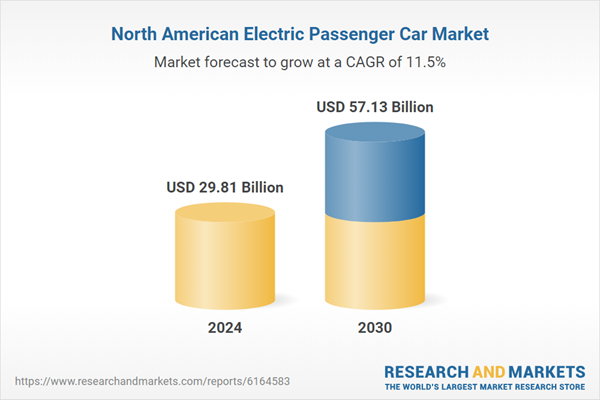Speak directly to the analyst to clarify any post sales queries you may have.
10% Free customizationThis report comes with 10% free customization, enabling you to add data that meets your specific business needs.
Electric passenger car demand in North America grows as consumers embrace sustainable transportation options. According to the U.S. Energy Information Administration, electricity consumption in the transportation sector rose by over 20% between 2022 and 2024, signaling increasing adoption of electric vehicles. Governments allocate funding for charging infrastructure and offer tax incentives, encouraging individuals and businesses to shift toward electric mobility. The International Energy Agency reports global EV sales surpassed 14 million units in 2023, reflecting momentum in electrification. Manufacturers commit billions of dollars to electric vehicle production and battery facilities, reshaping the automotive industry’s future.
Vehicle technology advances improve driving range, charging speed, and battery longevity. The U.S. Department of Energy highlights declining lithium-ion battery costs, falling to USD 139 per kilowatt-hour in 2024, from USD 153 in 2022. These cost reductions lower vehicle prices, broadening EV affordability. Consumers seek vehicles offering modern features like connectivity, over-the-air updates, and advanced driver-assistance systems. Electric cars appeal for lower running costs due to reduced fuel expenses and simplified maintenance compared to internal combustion vehicles. The American Automobile Association notes EV owners spend roughly 60% less on fuel annually than gasoline vehicle drivers, further stimulating market interest.
Manufacturers confront challenges such as sourcing critical minerals like lithium, nickel, and cobalt, crucial for battery production. According to the U.S. Geological Survey, lithium demand grew by over 30% in 2023, putting pressure on supply chains. Grid capacity concerns emerge as charging demand surges, prompting investments in smart charging solutions to balance load. Market growth faces hurdles from consumer concerns about charging access in rural regions and cold-weather range performance. Despite obstacles, policy support, technological progress, and growing environmental consciousness ensure the market remains on an upward path, redefining mobility across North America.
Market Drivers
Government Incentives
Policies promoting electric vehicles provide financial relief for consumers and businesses alike. Tax credits, rebates, and grants reduce the upfront costs of purchasing electric cars. The U.S. Department of Energy reports federal tax credits of up to USD 7,500 remain in place for eligible vehicles, helping offset higher initial prices. State-level programs layer further savings through rebates and discounts on vehicle purchases and home charger installations. These incentives stimulate market adoption by improving affordability for a wider range of buyers. Government support continues expanding to encourage domestic manufacturing and battery production, further strengthening the electric vehicle ecosystem.Key Market Challenges
Critical Mineral Supply
Electric vehicles depend on minerals such as lithium, nickel, and cobalt, which face increasing global demand and potential supply constraints. The U.S. Geological Survey reports lithium demand surged by more than 30% in 2023, driven largely by battery production. Mining operations often concentrate in a few regions, creating geopolitical risks and price volatility. Supply chain disruptions or export restrictions can disrupt manufacturing timelines and escalate costs. Automakers seek alternative chemistries or recycling solutions to mitigate reliance on scarce resources. Without stable mineral supplies, production targets and affordability goals for electric vehicles remain vulnerable, posing challenges for market expansion.Key Market Trends
Fast-Charging Advances
Technological progress drives faster charging capabilities, reducing wait times and improving convenience for EV owners. The U.S. Department of Energy highlights research into ultra-fast charging systems capable of delivering significant range in minutes rather than hours. High-power chargers of 350 kW or more become more common along highways and urban corridors. Faster charging enhances vehicle practicality for long-distance travel, alleviating range anxiety. Manufacturers adapt vehicle designs to handle higher charging currents safely. As networks expand, fast-charging stations enable electric vehicles to fit seamlessly into consumer lifestyles, accelerating the transition away from fossil fuel reliance.Key Market Players
- Audi AG
- BAIC Motor Corporation Ltd.
- BMW AG
- BYD Company Limited
- Ford Motor Company
- General Motors Company
- Hyundai Motor Company
- Nissan Motor Company
- Tesla Inc.
- Volkswagen AG
Report Scope:
In this report, the North America Electric Passenger Car Market has been segmented into the following categories, in addition to the industry trends which have also been detailed below:North America Electric Passenger Car Market, By Vehicle:
- Hatchback
- Sedan
- SUV/MPV
North America Electric Passenger Car Market, By Type:
- Battery Electric Vehicle
- Plug-in Hybrid Electric Vehicle
North America Electric Passenger Car Market, By Range:
- Above 150 miles
- Up to 150 miles
North America Electric Passenger Car Market, By Country:
- United States
- Canada
- Mexico
Competitive Landscape
Company Profiles: Detailed analysis of the major companies present in the North America Electric Passenger Car Market.Available Customizations:
North America Electric Passenger Car Market report with the given market data, TechSci Research, offers customizations according to the company’s specific needs. The following customization options are available for the report.Company Information
- Detailed analysis and profiling of additional market players (up to five).
Table of Contents
Companies Mentioned
- Audi AG
- BAIC Motor Corporation Ltd.
- BMW AG
- BYD Company Limited
- Ford Motor Company
- General Motors Company
- Hyundai Motor Company
- Nissan Motor Company
- Tesla Inc.
- Volkswagen AG
Table Information
| Report Attribute | Details |
|---|---|
| No. of Pages | 188 |
| Published | August 2025 |
| Forecast Period | 2024 - 2030 |
| Estimated Market Value ( USD | $ 29.81 Billion |
| Forecasted Market Value ( USD | $ 57.13 Billion |
| Compound Annual Growth Rate | 11.4% |
| Regions Covered | North America |
| No. of Companies Mentioned | 10 |









